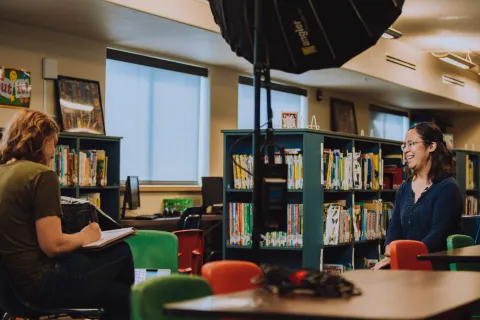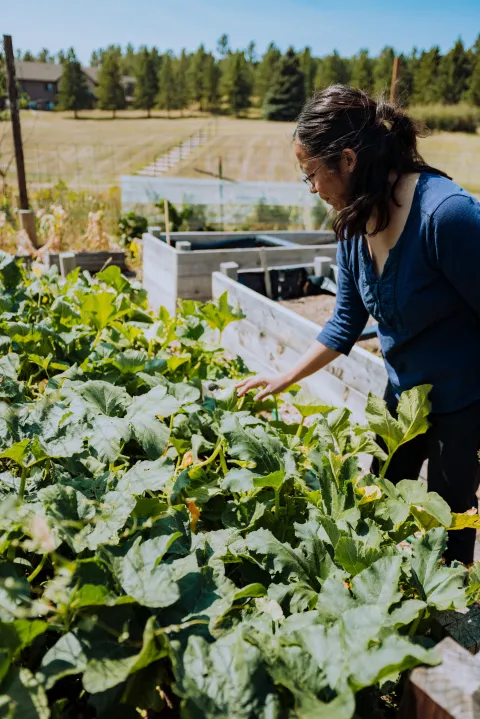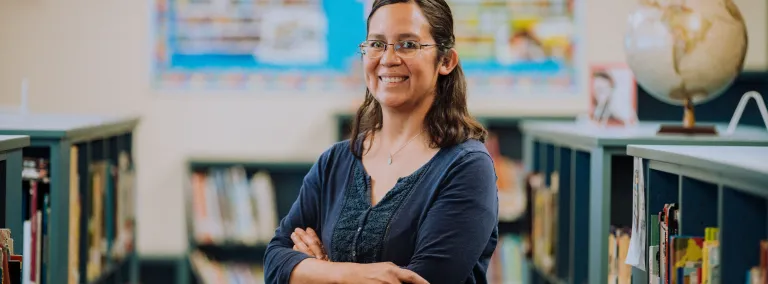Helping students see themselves as future scientists
Brenda Mizenko shares about her passion for exploratory learning at St. Elizabeth Seton in Rapid City, South Dakota
Brenda Mizenko once led a group of six- and seven-year-old entomologists on an exploratory excursion along a hillside in Spokane, Washington. The young scientists scoured the trail, uncovering and classifying insects as they went. The outing, which was referred to as “field work,” rather than a “field trip,” was part of Mizenko’s first- and second-grade unit on insects at an expeditionary learning school. The school focused on project-based learning and units—like this insect one—which addressed science, social studies, mathematics and language arts studies through a central theme.
Mizenko enjoyed the expeditionary teaching approach. It was a few years later, after attending a nationwide teachers academy, that she realized the urgency behind the approach: by fifth grade, most students have made up their minds whether they can see themselves as scientists.
This is a big deal. A student’s self-perceived potential as a scientist early on can determine how much effort they put into their science and math courses, whether they elect to take more advanced STEM courses in high school, and whether they join STEM clubs or activities.
“I thought, ‘these kids are going to decide—while I have them in class—whether they're going to like science, math, or anything in STEM fields. What can I do to encourage them?’” Mizenko came back from the teachers academy energized and looking for opportunities for her students to see themselves as scientists.
Finding local support
By that time, Mizenko was an elementary teacher at St. Elizabeth Seton Elementary School (Seton) in Rapid City, South Dakota. She began researching local science programs and connected with Sanford Underground Research Facility’s (SURF) Education and Outreach (E&O) team. Mizenko, along with other third- and fourth-grade teachers at Seton, requested SURF’s “Too Much, Too Little” curriculum unit to try out in their classrooms.
Through the unit, students explored the phenomena of flood and drought by analyzing maps, graphing weather data and considering local water issues. By bringing the issues close to home, the unit helped students contemplate potential solutions for water problems facing their own communities.
“It wasn’t just the kids that already liked science,” Mizenko said. “By the end of those units, every student was really wanting more.”

Mizenko was soon piloting a new curriculum unit—testing out the E&O ideas in a classroom environment—and volunteering during SURF’s Neutrino Day festival. She also hosted an E&O in-class presentation, so students could hear about underground science happening in their state and even try on real personal protective equipment and cleanroom suits worn by scientists.
“Brenda models being a curious learner,” said Julie Dahl, science education specialist at SURF who presented in Mizenko’s classroom. “When we do presentations in her classroom, she sits in the back of the room, and she takes notes. She really does an amazing job sharing that desire to learn with her kids. And you can feel it when you go into her classroom.”
Becoming a teacher-researcher
Driven by that desire to learn, Mizenko took on the role of researcher, herself. Through the South Dakota Mines (Mines) Research Experience for Teachers program, she spent a summer working alongside an environment and climate professor at Mines.
Based on this experience, Mizenko created a project for her students during their weather unit. She purchased a weather station with grant funds and worked with students to commission it and mount it on the playground fence. In the classroom, students watched data stream in, learned to analyze what the numbers meant then delivered weather announcements.
“The kids would get on the loudspeaker and give the weather report for the day, letting other students know if they would need their jackets during recess or not,” Mizenko said.
Tending to STEM learning
Mizenko’s latest project-based learning initiative is Junior Master Gardeners. In 2021, Mizenko received the Kelly Lane Earth and Space Science Grant, which provided funding to implement the Junior Master Gardeners curriculum at Seton. The school has a greenhouse and small garden area with planters and even a few ripening pumpkins. And Mizenko is excited to dig into the program and the garden with students.

“Students have a lot to learn from gardening,” Mizenko said. “It helps them see where their food comes from. It promotes healthy eating. And it teaches them that gardening is more than just planting a seed and watching it grow. You’ve got to do a lot of things to it to keep that seed going. We have to feed it, water it. Sometimes the soil has the right nutrients and sometimes it doesn’t. And you can experiment with that.”
Once the program takes root at Seton, Mizenko hopes to expand Junior Master Gardeners to other school districts, too.
Teaching and leading
Last year, Mizenko was chosen to serve in the South Dakota Department of Education’s SD Math/SD Sci Teacher Leadership Cohort program, which is co-facilitated by SURF’s E&O team. She was also a state finalist for the Presidential Award for Excellence in Mathematics and Science Teaching.
“I am working toward more leadership roles in science education statewide,” Mizenko said. “Being in these roles gives me a voice, both representing my district at the state level, and also coming back to my district and letting other teachers know what’s happening at the state level.”
As this school year begins, Mizenko is transitioning from her role as a classroom teacher to that of librarian and STEAM lab coordinator. Instead of one class, she’ll be able to teach literacy and STEM subjects to all the students at Seton, from preschool to fifth grade.
By creating projects that encourage students to take ownership of their learning—whether they are looking for bugs, making weather reports, considering local water issues or tending their garden—in Mizenko’s classroom, students see themselves for what they can be, our future scientists.
